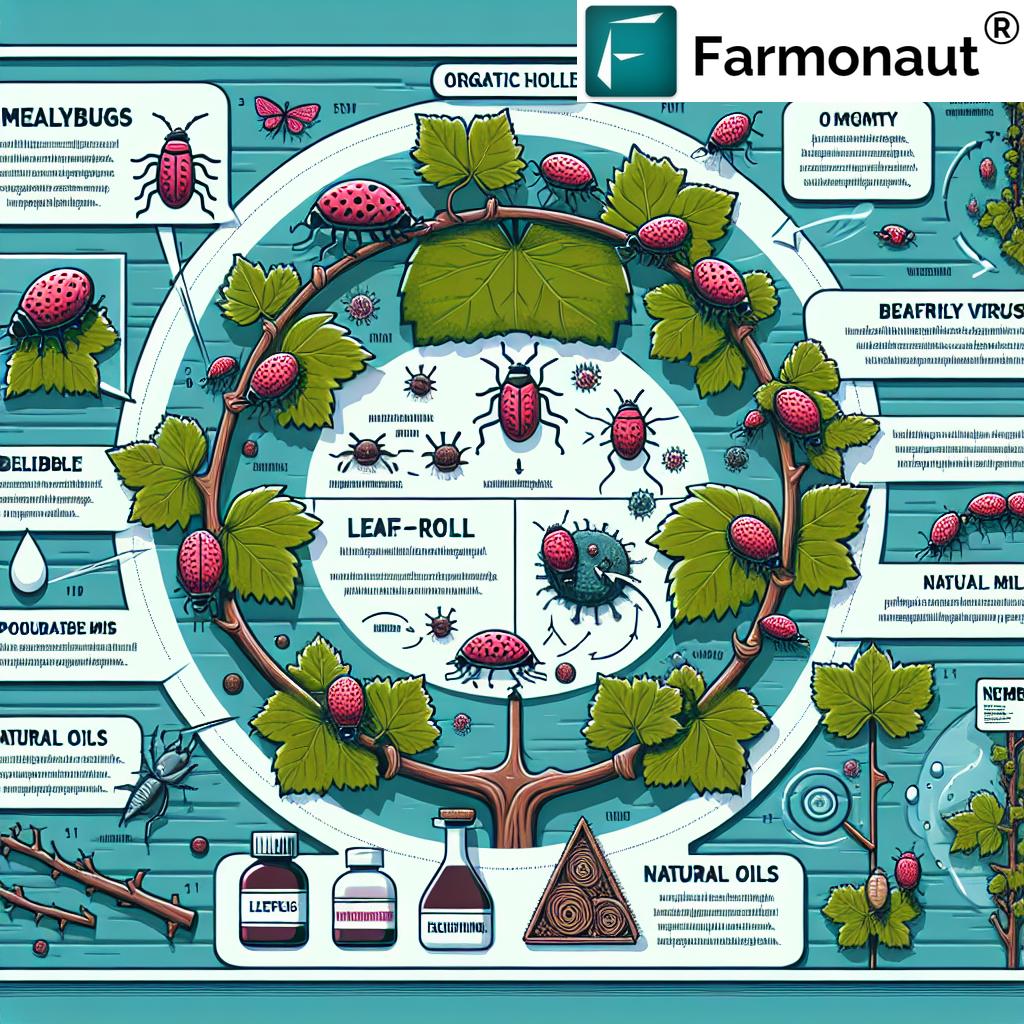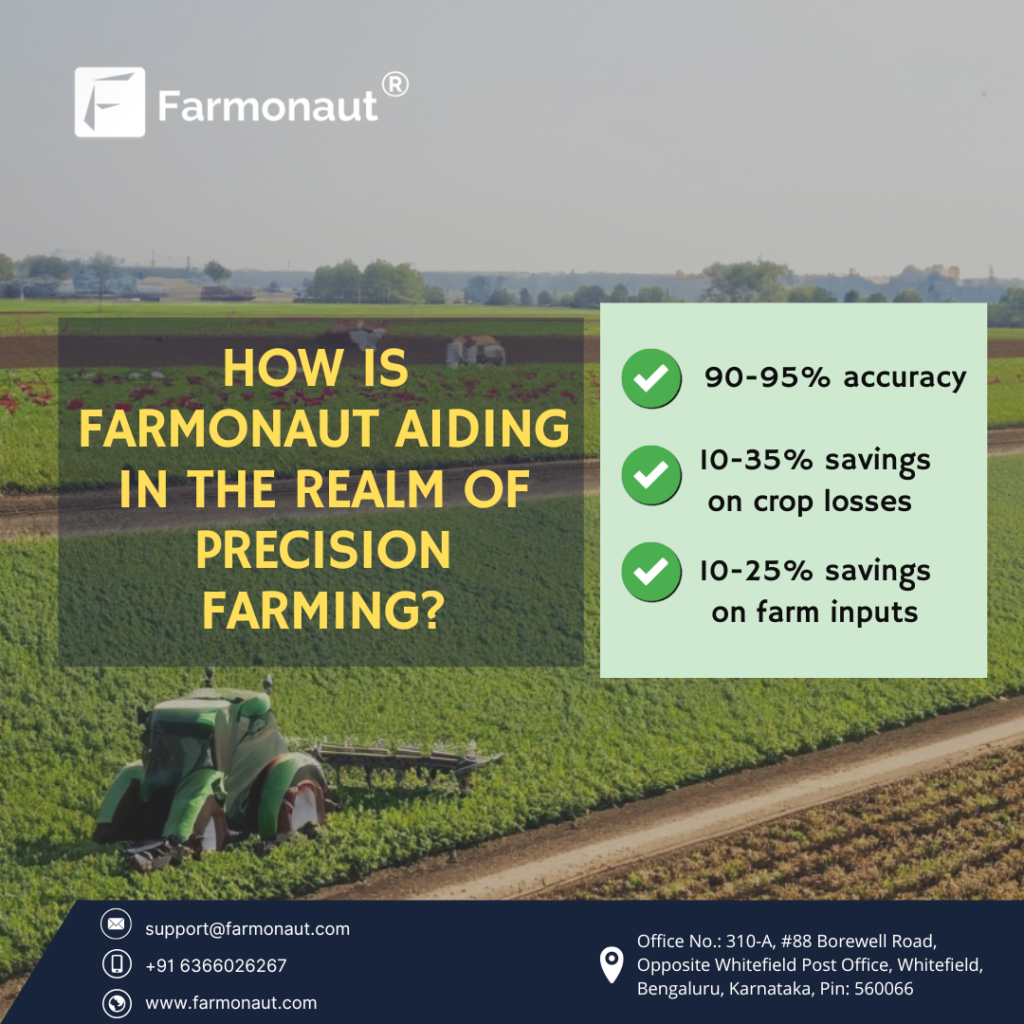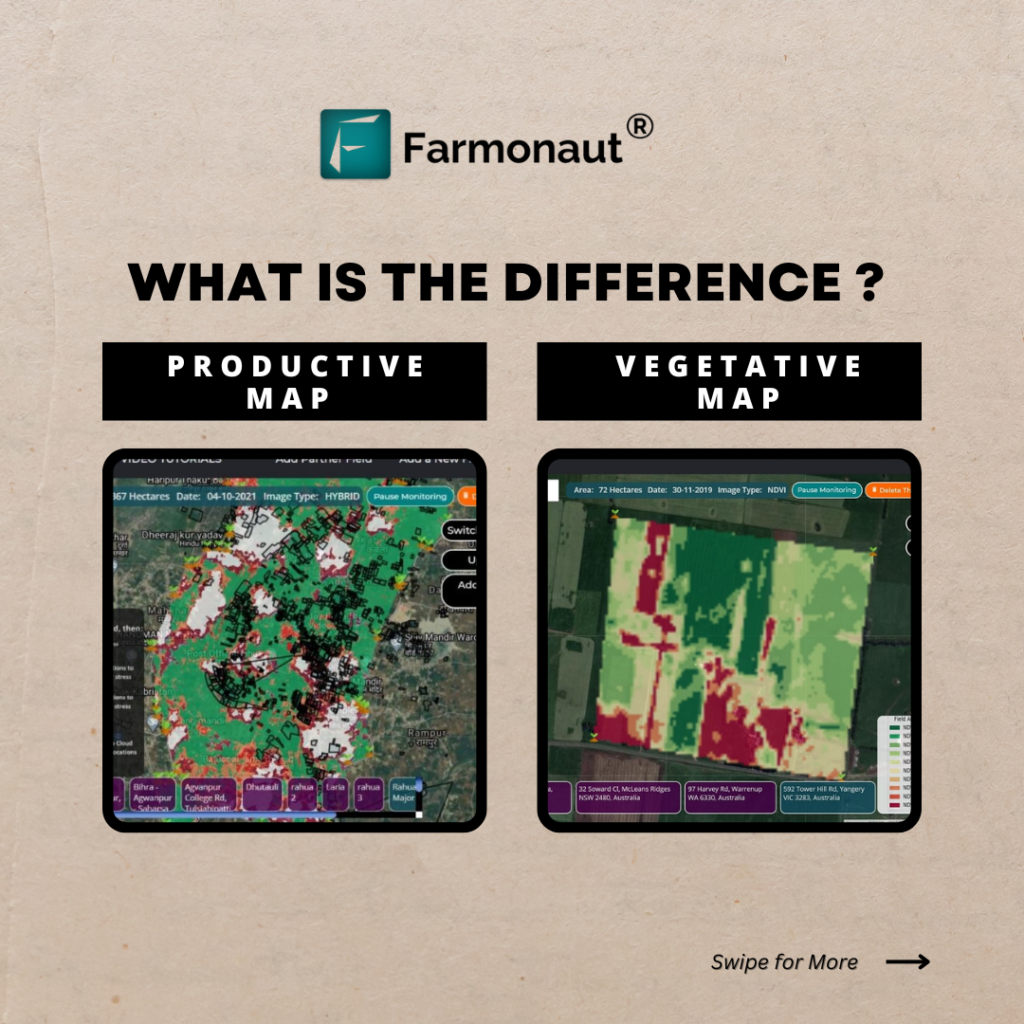Grapevine Leafroll Disease: Organic and Chemical Control Strategies for Infected Vineyards

In the world of viticulture, grapevine leafroll disease (GLD) stands as one of the most significant challenges faced by vineyard managers and wine producers. This complex viral disease affects grapevines worldwide, causing substantial economic losses and compromising the quality of wine production. At Farmonaut, we understand the critical importance of addressing this issue effectively and sustainably. In this comprehensive guide, we’ll explore the intricacies of grapevine leafroll disease, its symptoms, transmission vectors, and most importantly, the organic and chemical control strategies available to combat this persistent threat in vineyards.
Understanding Grapevine Leafroll Disease
Grapevine leafroll disease is caused by a complex of viruses belonging to the family Closteroviridae, with Grapevine leafroll-associated virus 3 (GLRaV-3) being the most widespread and economically important. This disease affects both red and white grape varieties, though symptoms may vary depending on the cultivar.
Symptoms of Grapevine Leafroll Disease
The symptoms of grapevine leafroll disease can be subtle and easily overlooked, especially in the early stages of infection. However, as the disease progresses, several characteristic signs become apparent:
- Red grape varieties:
- Leaves turn red or reddish-purple, starting from the base of the leaf blade near the petiole
- Main veins remain green
- Leaf margins roll downward, giving the disease its name
- White grape varieties:
- Leaves may show yellowing or chlorosis
- Leaf rolling is still present but may be less pronounced
- General symptoms:
- Delayed fruit ripening
- Reduced sugar content in berries
- Decreased vine vigor and yield
- Poor coloration in red varieties

Transmission and Spread of Grapevine Leafroll Disease
Understanding how grapevine leafroll disease spreads is crucial for developing effective control strategies. The primary vectors and transmission methods include:
1. Mealybugs and Soft Scale Insects
Mealybugs are the most significant vectors of grapevine leafroll-associated viruses. These small, soft-bodied insects feed on the phloem of grapevines and can acquire and transmit the virus as they move from plant to plant. Several species of mealybugs are known to transmit GLD, including:
- Planococcus ficus (vine mealybug)
- Pseudococcus longispinus (longtailed mealybug)
- Pseudococcus calceolariae (citrophilus mealybug)
Soft scale insects, although less efficient vectors, can also transmit the virus.
2. Grafting and Propagation
The use of infected plant material for grafting or propagation is a significant means of long-distance spread of grapevine leafroll disease. This emphasizes the importance of using certified virus-free planting material when establishing new vineyards or replacing vines.
3. Root Grafting
In some cases, the virus can spread through root grafts between adjacent infected and healthy vines, although this is generally considered a minor route of transmission compared to insect vectors and propagation practices.
The Impact of Grapevine Leafroll Disease on Wine Production
Grapevine leafroll disease can have severe economic consequences for wine producers. The effects of the disease on grape and wine quality include:
- Reduced sugar accumulation in berries
- Increased acidity
- Delayed and uneven ripening
- Reduced anthocyanin content in red varieties, affecting wine color
- Lower yield due to reduced berry size and cluster weight
- Altered flavor profiles in the resulting wines
These factors collectively contribute to a decrease in wine quality and economic losses for vineyard owners and winemakers.
Control Strategies for Grapevine Leafroll Disease
Managing grapevine leafroll disease requires an integrated approach that combines preventive measures, vector control, and vineyard management practices. At Farmonaut, we advocate for a balanced strategy that incorporates both organic and chemical control methods to effectively combat this disease while minimizing environmental impact.
Organic Control Methods
Organic approaches to managing grapevine leafroll disease focus on cultural practices, biological control, and the use of natural products. These methods are particularly important for vineyards transitioning to organic production or those seeking to reduce reliance on synthetic chemicals.
- Sanitation and Cultural Practices
- Remove and destroy infected vines to reduce the reservoir of virus in the vineyard
- Implement strict sanitation protocols for pruning tools and equipment
- Maintain good weed control to reduce alternative hosts for mealybugs
- Avoid excessive nitrogen fertilization, which can promote mealybug populations
- Biological Control
- Encourage natural predators of mealybugs, such as ladybirds, lacewings, and parasitic wasps
- Release commercially available beneficial insects like Cryptolaemus montrouzieri (mealybug destroyer) or Anagyrus pseudococci (parasitic wasp)
- Manage ant populations, as ants protect mealybugs from natural enemies
- Natural Insecticides and Repellents
- Use natural oils such as neem oil or horticultural oils to suffocate mealybugs
- Apply insecticidal soaps to control mealybug populations
- Utilize botanical insecticides derived from plants like pyrethrum or rotenone (with caution and in accordance with local regulations)
- Mating Disruption
- Deploy pheromone dispensers to disrupt mealybug mating, reducing population growth
Chemical Control Methods
While organic approaches form the foundation of sustainable disease management, chemical control methods can play a crucial role in severe infestations or as part of an integrated pest management strategy.
- Systemic Insecticides
- Apply systemic neonicotinoids like imidacloprid or thiamethoxam as soil drenches or foliar sprays
- Use spirotetramat, which has shown efficacy against mealybugs while having a lower impact on beneficial insects
- Contact Insecticides
- Utilize organophosphates or carbamates for immediate control of visible mealybug populations
- Apply pyrethroids, being mindful of their broad-spectrum nature and potential impact on beneficial insects
- Insect Growth Regulators
- Use buprofezin or pyriproxyfen to disrupt the molting process of mealybugs, preventing their development
It’s crucial to note that the use of insecticides should be carefully timed and rotated to prevent the development of resistance in mealybug populations. Always follow local regulations and guidelines for pesticide use in vineyards.
Integrated Pest Management (IPM) for Grapevine Leafroll Disease
At Farmonaut, we strongly advocate for an Integrated Pest Management approach to controlling grapevine leafroll disease. This strategy combines various control methods to achieve long-term, sustainable management of the disease and its vectors. Key components of an effective IPM program include:
- Regular monitoring of vine health and mealybug populations
- Use of economic thresholds to guide treatment decisions
- Implementation of cultural, biological, and chemical control methods as needed
- Conservation of natural enemies through selective use of pesticides
- Continuous evaluation and adjustment of management strategies
The Role of Technology in Grapevine Leafroll Disease Management
Advancements in agricultural technology have opened new avenues for managing grapevine leafroll disease more effectively. At Farmonaut, we leverage cutting-edge satellite imaging and AI-driven analytics to provide vineyard managers with powerful tools for disease detection and management.
Satellite-Based Crop Health Monitoring
Our satellite-based crop health monitoring system offers several advantages in the fight against grapevine leafroll disease:
- Early detection of disease symptoms through multispectral imagery
- Precise mapping of infected areas within vineyards
- Tracking of disease spread over time
- Optimization of treatment strategies based on real-time data
To illustrate the benefits of our technology, let’s compare traditional methods with Farmonaut’s satellite system for grapevine leafroll disease detection:
| Aspect | Traditional Methods | Farmonaut Satellite System |
|---|---|---|
| Detection Speed | Slow, manual scouting required | Rapid, automated detection |
| Coverage | Limited to accessible areas | Complete vineyard coverage |
| Precision | Variable, dependent on scout expertise | High precision, AI-driven analysis |
| Frequency | Periodic, labor-intensive | Regular updates based on satellite passes |
| Data Integration | Manual record-keeping | Automated, GIS-compatible data |
| Cost-effectiveness | High labor costs for large vineyards | Scalable, cost-effective for any size |
By leveraging Farmonaut’s technology, vineyard managers can significantly improve their ability to detect and respond to grapevine leafroll disease outbreaks, ultimately leading to more effective disease management and reduced economic losses.
Long-Term Strategies for Grapevine Leafroll Disease Prevention
Preventing grapevine leafroll disease is often more effective and economical than treating infected vineyards. Here are some long-term strategies that vineyard managers should consider:
- Use of Certified Virus-Free Planting Material
- Source vines and rootstocks from reputable nurseries that provide certified virus-free material
- Implement quarantine measures for new plantings to prevent introduction of infected material
- Vineyard Design and Management
- Plan vineyard layouts to minimize disease spread, including buffer zones between blocks
- Implement rigorous hygiene practices for all vineyard operations
- Consider removing old, infected vineyards and replanting with virus-free material
- Ongoing Monitoring and Early Intervention
- Conduct regular visual inspections, especially during periods when symptoms are most visible
- Utilize Farmonaut’s satellite monitoring system for early detection of disease symptoms
- Implement prompt roguing (removal) of infected vines when detected
- Vector Management
- Develop a comprehensive strategy for managing mealybug populations year-round
- Monitor and control ant populations, which can protect and spread mealybugs
- Implement cover cropping and habitat management to encourage natural predators
- Education and Training
- Provide ongoing education for vineyard staff on disease symptoms, vector identification, and best management practices
- Stay informed about the latest research and control strategies for grapevine leafroll disease
The Future of Grapevine Leafroll Disease Management
As research into grapevine leafroll disease continues, new management strategies and technologies are emerging. Some promising areas of development include:
- Resistant Varieties: Breeding programs are working to develop grapevine varieties with increased resistance to leafroll-associated viruses.
- RNA Interference (RNAi) Technology: This approach aims to silence viral genes, potentially offering a new method of disease control.
- Advanced Diagnostics: Development of rapid, field-based diagnostic tools for early detection of viral infections.
- Precision Agriculture: Integration of drone technology, IoT sensors, and machine learning for more precise disease management.
At Farmonaut, we are committed to staying at the forefront of these technological advancements, continuously improving our satellite-based monitoring system to provide vineyard managers with the most effective tools for disease management.
Conclusion
Grapevine leafroll disease presents a significant challenge to vineyard managers and wine producers worldwide. However, with a comprehensive understanding of the disease, its vectors, and the available control strategies, it is possible to effectively manage and mitigate its impact. By combining organic and chemical control methods within an integrated pest management framework, and leveraging advanced technologies like Farmonaut’s satellite monitoring system, vineyard managers can protect their crops, maintain wine quality, and ensure the long-term sustainability of their operations.
Remember, successful management of grapevine leafroll disease requires a holistic, adaptive approach. Stay informed about the latest research, remain vigilant in monitoring your vineyards, and don’t hesitate to seek expert advice when needed. With the right strategies and tools, we can work together to keep our vineyards healthy and productive for generations to come.
FAQ Section
Q1: Can grapevine leafroll disease be cured?
A1: Unfortunately, there is no cure for grapevine leafroll disease once a vine is infected. The virus remains in the plant for its lifetime. Management strategies focus on preventing spread, controlling vectors, and removing infected vines.
Q2: How long can a grapevine infected with leafroll disease survive?
A2: Infected vines can survive for many years, but their productivity and fruit quality will decline over time. The rate of decline depends on factors such as the grape variety, virus strain, and environmental conditions.
Q3: Are some grape varieties more resistant to leafroll disease?
A3: While no grape varieties are completely resistant to leafroll disease, some show fewer symptoms or are less affected in terms of yield and quality. Research is ongoing to develop more resistant varieties.
Q4: How effective are insecticides in controlling mealybugs and preventing disease spread?
A4: Insecticides can be effective in reducing mealybug populations, but they should be used as part of an integrated pest management strategy. Proper timing, application method, and rotation of active ingredients are crucial for effectiveness.
Q5: Can organic vineyards effectively manage grapevine leafroll disease?
A5: Yes, organic vineyards can manage leafroll disease through a combination of cultural practices, biological control, and approved organic treatments. While it may be more challenging, many organic vineyards successfully control the disease and its vectors.
Q6: How does climate change affect the spread of grapevine leafroll disease?
A6: Climate change can potentially exacerbate the spread of leafroll disease by altering mealybug life cycles and expanding their geographical range. Warmer temperatures may lead to increased vector populations and faster disease progression.
Q7: Is it safe to consume wine from leafroll-infected grapes?
A7: Yes, it is safe to consume wine made from leafroll-infected grapes. The disease affects grape quality and yield but does not pose health risks to consumers. However, the quality of the wine may be compromised.
Q8: How can Farmonaut’s technology help in early detection of grapevine leafroll disease?
A8: Farmonaut’s satellite-based monitoring system uses multispectral imagery to detect subtle changes in vine health that may indicate leafroll infection. This allows for early detection and targeted management before symptoms become visually apparent.
Q9: Are there any biological control methods that are particularly effective against mealybugs?
A9: Several natural predators and parasitoids have shown effectiveness against mealybugs, including the mealybug destroyer beetle (Cryptolaemus montrouzieri) and certain parasitic wasps. Their effectiveness can vary depending on the specific mealybug species and environmental conditions.
Q10: How often should vineyards be monitored for leafroll disease symptoms?
A10: Regular monitoring is crucial, especially during late summer and fall when symptoms are most visible. With Farmonaut’s satellite monitoring, vineyards can be assessed frequently without the need for constant manual scouting, allowing for more timely interventions.












